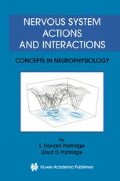Abstract
Muscle activity results in effects as diverse as external locomotion of the body and the internal movement of substances in the cardiovascular and gastrointestinal systems. Muscles also play an important role in the control of body heat because they generate heat, regulate heat loss through blood vessels in the skin, conserve heat by the movement of hairs, and allow an animal to move to a different temperature environment. Muscle is not a simple transducer of nerve signals, but is an active processor of neural signals. While mechanical response is strongly dependent upon neural drive over an appreciable period time, muscle activity depends almost as much on the mechanical interactions with its load. The kinesiological role of muscle has already been considered, and this chapter will be concerned with the operation of muscle itself.
Access this chapter
Tax calculation will be finalised at checkout
Purchases are for personal use only
Preview
Unable to display preview. Download preview PDF.
References
References
Best, P.M., Kwok, W., and Xu, X. (1991) Calcium channels in excitation-contraction coupling, in: Calcium Channels: Their Properties, Functions, Regulation, and Clinical Relevance. L. Hurwitz, L.D. Partridge, and J. Leach (eds.). CRC Press, Boca Raton, FL.
Bizzi, E., Accorneio, N., Chappie, W., and Hogan, N. (1982) Arm trajectory formation in monkeys. Exp. Brain Res. 46:139–143.
Feldman, A.G. (1966) Functional tuning of the nervous system with control of movement or maintenance of a steady posture. II: controllable parameters of the muscle. Biophysics 11:565–578.
Gordon, A.M. Regnier, M., Homsher, E. (2001) Skeletal and cardiac muscle contractile activation: Tropomyosin “rocks and rolls” News Physiol. Sci. 16:49–55.
Gordon, A.M., Homsher, E., Regnier, M. (2000) Regulation of contraction in striated muscle. Physiol. Rev. 80:853–924.
Kimura, J. (2001) Electrodiagnosis in Diseases of Nerve and Muscle: Principles and Practice, 3rd ed. Oxford Univ. Press, Oxford.
Partridge, L.D. (1966) Signal-handling characteristics of load-moving skeletal muscle. Am. J. Physiol. 210:1178–1191.
Partridge, L.D. (1967) Intrinsic feedback factors producing inertial compensation in muscle. Biophys. J. 7:853–863.
Partridge, L.D., and Benton, L.A. (1981) Muscle the motor. Handbook of Physiology, The Nervous system, Vol. II, Ch. 3. Williams & Wilkins, Baltimore.
Squire, J.M. (ed.)(1990) Molecular Mechanisms in Muscular Contraction. CRC Press, Boca Raton, FL.
Stein, R.,B. (1980) Nerve and Muscle Membranes, Cells, and Systems. Plenum, New York.
Zigmond, M.J., Bloom, F.E., Landis, S.C., Roberts, J.L., Squire, L.R. (1999) Fundamental Neuroscience, (chapter 30) Academic Press, San Diego
Additional Reading
Blix, M. (1893) Die Länge und Spannung des Muskels. Skand. Arch. Physiol. 4:399–409.
Gordon, A.M., Huxley, A.F., and Julian, F.J. (1966) The variation of isometric tension with sarcomere length in vertebrate muscle fibers. J. Physiol. 184:170–192.
Hill, A.V. (1938) The heat of shortening and the dynamic constants of muscle. Proc. R. Soc. London 126:136
Hill, A.V. (1965) Trails and Trials in Physiology. Williams and Wilkins, Baltimore.
Huxley, A.F. (1977) Looking back on muscle. In The Pursuit of Nature. Cambridge University Press, Cambridge.
Huxley, A.F., and Simmons, R.M. (1971) Proposed mechanism of force generation in striated muscle. Nature (London) 233:533–538.
Huxley, H.E. (1956) The ultra-structure of striated muscle. Br. Med. Bull. 12:171–173
Johnston, F.D. (1961) The electrocardiogram. In Pathologic Physiology, pp. 449–471, Sodeman, W.A. (ed.). Saunders, Philadelphia.
Joyce, G.C., Rack, P.M.H. (1969) Isotonic lengthening and shortening movements of cat soleus muscle. J. Physiol. 204:475–491.
Levin, A., and Wyman, J. (1927) The viscous elastic properties of muscle. Proc. R. Soc. London 101B:218–243.
Loewy, A.G. (1952) An actinomyosin-like substance from the Plasmodium of a myxomycete. J. Cell. Comp. Physiol. 40:127–156.
Starling, E.H. (1918) Linacre Lecture on the Law of the Heart. Longmans Green, NY.
Weber, E. (1846) Muskelbewegnung. In Handwörterbuch der Physiologie. R. Wagner (ed.). Bieweg, Brunswick, Germany.
Author information
Authors and Affiliations
Rights and permissions
Copyright information
© 2003 Springer Science+Business Media New York
About this chapter
Cite this chapter
Partridge, L.D., Partridge, L.D. (2003). Muscle Activity. In: Nervous System Actions and Interactions. Springer, Boston, MA. https://doi.org/10.1007/978-1-4615-0425-2_14
Download citation
DOI: https://doi.org/10.1007/978-1-4615-0425-2_14
Publisher Name: Springer, Boston, MA
Print ISBN: 978-1-4613-5070-5
Online ISBN: 978-1-4615-0425-2
eBook Packages: Springer Book Archive

